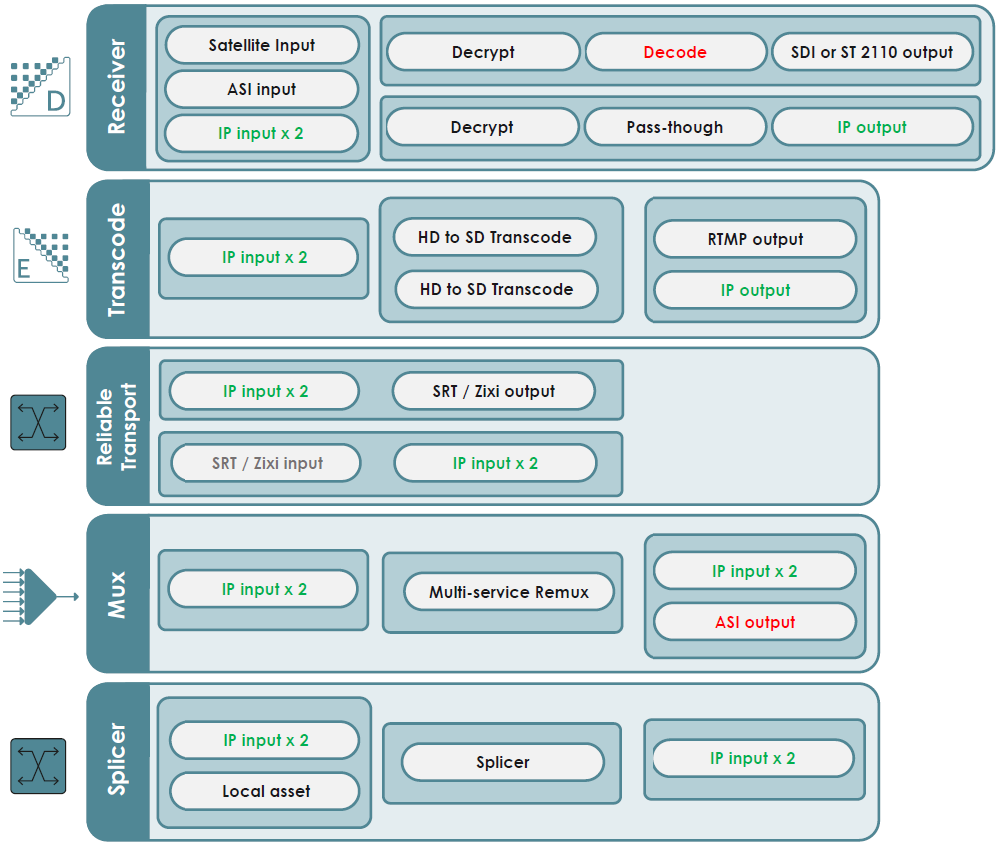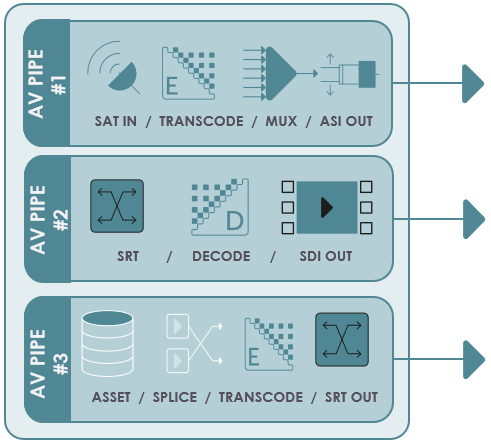MK.IO Beam Distribution (formerly RX1)
MK.IO Beam Distribution is designed as a highly flexible edge device. It provides a set of processing functions that allows the user to create a flexible end-to-end flow.
Components
Service types
The following service types are provided by MK.IO Beam Distribution.
Receiver
The Receiver function can be configured with ASI, Satellite or IP input and can be set into one of the following three modes: Pass-through, SD/HD Decode or UHD Decode. Input redundancy mechanisms are supported, notably ST2022-7 for the IP input mode. When set to pass-through mode, the Receiver service outputs the signal as a Transport Stream over IP whereas the Decode modes output the signal as SDI or SMPTE ST 2110. Both modes have a decryption stage with a variety of decryption types such as BISS Mode 1, BISS Mode E, BISS-CA, Director and DVB-CI/CAM.
Live Encoding
The Live Encoding function takes an IP Live Encoding input and performs transcoding of a single video program with a video input of MPEG-2, H.264 or HEVC in SD or HD 4:2:0 resolutions. To achieve the required density, MK.IO Beam Distribution is configured with Hardware acceleration (Intel QSV) and allows transcoding to MPEG-2, H.264 or HEVC in SD or HD 4:2:0 resolutions. Audio can be transcoded or pass-through and other meta-data such as SCTE-35 and DVB-Subtitles can also be passed through to the output program. IP input is supported but SDI or SMPTE ST 2110 input are not supported in MK.IO Beam Distribution.
Multiplexing
The Multiplexing function takes in a Multiple Program Transport Stream and recreates an output Transport Stream with a choice of PIDs from the input to achieve the PID filtering and PID remapping function. It also supports re-multiplexing by passing-through a whole input program from the input to the output. Scrambling functions and Statistical Multiplexing functions are not supported in MK.IO Beam Distribution.
Reliable Transport
The Reliable Transport function takes in UDP packets and outputs them as either SRT (caller or listener), Zixi (feeder) or RIST (listener). It can also take in SRT input (caller or listener), Zixi input (receiver) or RIST (caller) and output the content as UDP or any of the other protocols. The UDP content is processed as a pipe without any modification to the UDP content and is typically used -but not solely- to carry Transport stream encapsulated in UDP or RTP.
TS Splicer
The TS Splicer function enables splicing of content using SCTE-35 triggers based on message types it should trigger on. The video clip can either be retrieved from an external asset server or locally stored in the MK.IO Beam Distribution.
Stream Conditioning
The Stream Conditioning can be used with Live Encoder to trigger functions such as SCTE-35 rewrite, Animation/Text crawling, Slate/Logo insertion, live-to-file and file-to-live video switching using operation type Video clip.
Viewing Policy Manager
The Viewing Policy Manager is used to configure the ingest of programming events schedules. This has limited functionality in the current version of MK.IO Beam Distribution.
Solution Manager and Solution Manager Transcode
These cannot be enabled in the user interface. They are used for very specific deployments within a distribution system controlled by Director. Please talk to product management for the target use case.
 Processing Functions
Processing Functions
 Customized A/V Processing
Customized A/V Processing
Brief example of a channel configuration with multiple functions
The various functions can be created and configured as a chain to create a specific use case.
As an example, a Receiver service configured with a Satellite input can be set in pass-through mode and chained with a Live Encoding service to perform transcoding and output the transport stream over IP output.
The Transport Stream is carried from one function to another function as IP traffic using the internal network within the MK.IO Beam Distribution.
Limitations
- All services, with the exception of Receiver, are only offered with limited use cases. Please refer to MK.IO Beam Distribution Release notes for those supported use cases.
- The number of inputs, quantities of decode and output configurations defined in this section assume that only receiver services are running within the MK.IO Beam Distribution server. Addition of other services (as defined previously) may compromise the maximum performance of those services.
- When running receiver-only services, MK.IO Beam Distribution can run either 1 UHD service or up to 4 independent HD full bit rate services.
- When running receiver-only services, MK.IO Beam Distribution can support up to 4 passthrough services. Combinations of passthrough and decode receiver services are supported, this may be as many as 4 of each, however, the exact number depends upon the complexity of the decode services running.